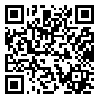Thu, Apr 18, 2024
| فارسی
Volume 22, Issue 1 (Spring 2020)
Advances in Cognitive Sciences 2020, 22(1): 102-115 |
Back to browse issues page
Download citation:
BibTeX | RIS | EndNote | Medlars | ProCite | Reference Manager | RefWorks
Send citation to:



BibTeX | RIS | EndNote | Medlars | ProCite | Reference Manager | RefWorks
Send citation to:
Matoori H, Gorjian B, Veysi E, Memari M. Temporal frames of reference in Persian speakers language based on conceptual metaphors theory. Advances in Cognitive Sciences 2020; 22 (1) :102-115
URL: http://icssjournal.ir/article-1-950-en.html
URL: http://icssjournal.ir/article-1-950-en.html
1- Department of General Linguistics, Abadan Branch, Islamic Azad University, Abadan, Iran
2- Associate Professor of Linguistics, Payame Noor University of Iran, Iran
3- Assistant Professor of TEFL Department, Farhangian University of Ahvaz, Ahvaz, Iran
2- Associate Professor of Linguistics, Payame Noor University of Iran, Iran
3- Assistant Professor of TEFL Department, Farhangian University of Ahvaz, Ahvaz, Iran
Abstract: (3187 Views)
Introduction: The present study aimed to examine the spatial-temporal mapping in Persian based on Lakoff and Johnson's conceptual metaphors theory to find the temporal frame reference its adoption sources. The metaphor of "time as space" is based on the hypothesis that we adopt an abstract concept such as time from an objective concept such as space and conceptualize it in our minds and languages.
Methods: The required data were analyzed by designing five experimental linguistic and non-linguistic experiments to achieve the research objectives. Experiments include temporal word arrangement, the arrangement of temporal stickers/tokens, and language elicitation with Wednesday meeting, picture arrangement, and co-speech gesture. One hundred fifty-five male and female students aged 18 to 54 from Islamic Azad University of Khorramshahr Branch and Abadan University of Medical Sciences participated in these experimental experiments.
Results: Samples’ percentage and frequency of occurrence illustrated that lateral axis from right to left adopted from Persian writing direction; sagittal axis back to front adopted from walking direction, looking direction, linguistic metaphors; lateral axis from left to right adopted from mathematics writing direction are the main sources of adoption of abstract temporal concepts in Persian.
Conclusion: This research implied that the adopted frame of reference and the sagittal or lateral axes are strongly influenced by the type of task, pattern and design of the experiment, the given concepts, language and linguistic metaphors, and cultural artifacts.
Methods: The required data were analyzed by designing five experimental linguistic and non-linguistic experiments to achieve the research objectives. Experiments include temporal word arrangement, the arrangement of temporal stickers/tokens, and language elicitation with Wednesday meeting, picture arrangement, and co-speech gesture. One hundred fifty-five male and female students aged 18 to 54 from Islamic Azad University of Khorramshahr Branch and Abadan University of Medical Sciences participated in these experimental experiments.
Results: Samples’ percentage and frequency of occurrence illustrated that lateral axis from right to left adopted from Persian writing direction; sagittal axis back to front adopted from walking direction, looking direction, linguistic metaphors; lateral axis from left to right adopted from mathematics writing direction are the main sources of adoption of abstract temporal concepts in Persian.
Conclusion: This research implied that the adopted frame of reference and the sagittal or lateral axes are strongly influenced by the type of task, pattern and design of the experiment, the given concepts, language and linguistic metaphors, and cultural artifacts.
Type of Study: Research |
Received: 2019/05/23 | Accepted: 2020/01/16 | Published: 2020/06/10
Received: 2019/05/23 | Accepted: 2020/01/16 | Published: 2020/06/10
Send email to the article author
| Rights and permissions | |
 |
This work is licensed under a Creative Commons Attribution-NonCommercial 4.0 International License. |






